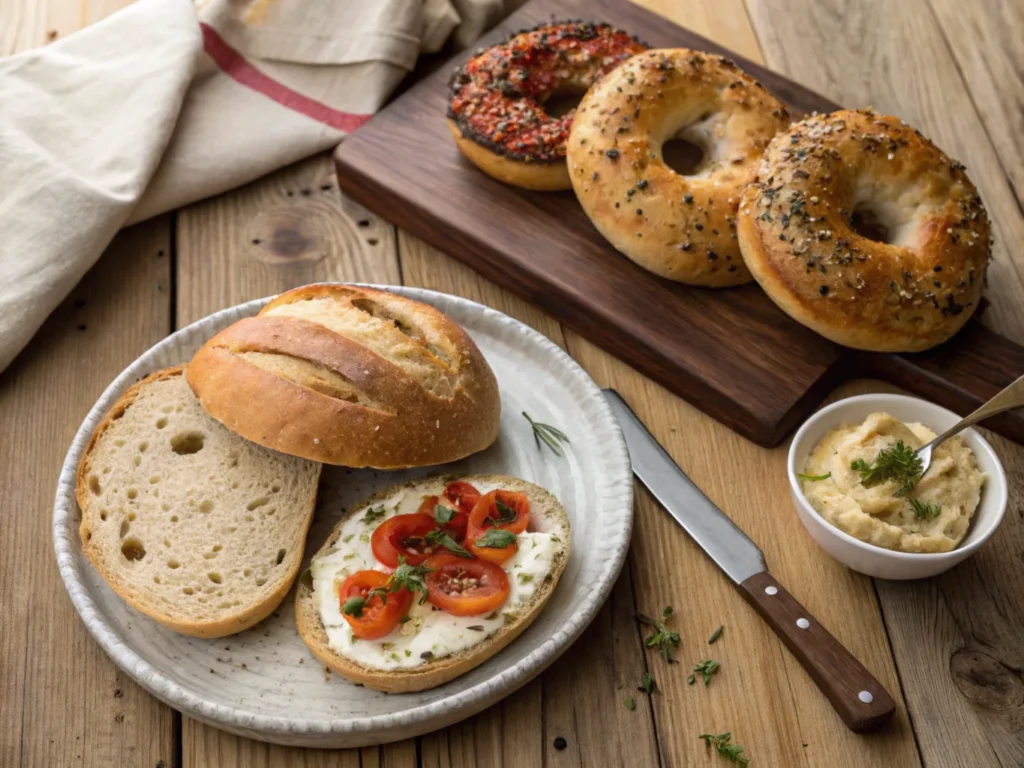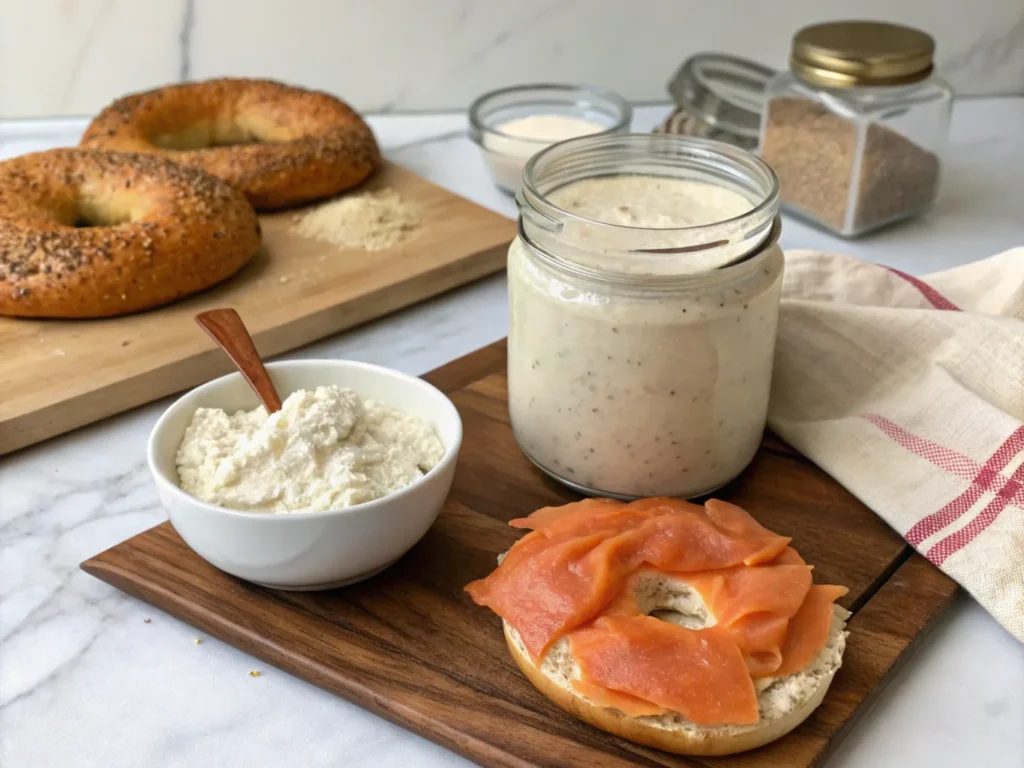If you’ve ever stood in front of the bakery aisle wondering, “Is sourdough bread healthy than regular bagels?“ you’re not alone. I’ve been there, too. Between the tangy chew of sourdough and the comforting heft of a toasted bagel, it can feel like a nutritional toss-up. But here’s the truth these two breakfast staples couldn’t be more different once you take a closer look at what’s inside and how they affect your body.

So, let’s break this down together. I’m not here to shame bagels (I love ‘em), but I’ll walk you through what makes sourdough a bit of a superstar in the bread world and when a bagel still deserves its time to shine.
Why This Bread vs Bagel Debate Actually Matters
“Is sourdough bread healthy than regular bagels?” Let’s face it, most of us don’t have time to obsess over every calorie. We just want to make better choices when it matters like breakfast. Choosing between sourdough bread and a regular bagel might seem simple, but it plays a bigger role in how full you feel, how steady your energy stays, and how your gut reacts.
We’re going to get into:
- What makes sourdough different
- The secret behind fermentation (yep, it’s got superpowers)
- What bagels bring to the table (besides cream cheese)
- Nutritional facts that actually matter
- And which one fits better into your weight loss or health goals
A Little Story From My Kitchen…
I’m Megan. If you had told little me that one day I’d be sharing my favorite recipes with the world on my own cooking website, I probably would’ve giggled and handed you a wooden spoon to help my grandma stir the pot.
Some of my best childhood memories were made in my grandmother’s kitchen. The smell of freshly baked bread, the sound of a sizzling pan, the way she always knew exactly how much salt to add without ever measuring it was pure magic. And I was hooked.
She let me “help” (which really meant making a mess), but over time, I started paying attention. Watching her cook was like learning a secret language. No words just love, instinct, and patience. That’s where my passion for food began, and sourdough? It was one of her staples. Now, I bake it for my family just like she did, and I’ve come to appreciate its quiet power when it comes to health.
Why Is Sourdough Bread Healthy Than Regular Bagels?
Is sourdough bread healthy than regular bagels? Sourdough bread has a pretty humble rep it’s rustic, tangy, and feels homemade. Regular bagels? They’re iconic. Think brunch spreads, New York-style delis, and “grab-and-go” mornings. But here’s the deal sourdough might be doing more behind the scenes to support your digestion, control your appetite, and even lower your blood sugar.
And guess what? Bagels can have their benefits too especially if you tweak the ingredients or size. It’s not always about what’s bad it’s about what fits your body and your day.
To really get a good look, we’ll talk calories, fiber, fermentation, and why your gut might love one more than the other. And I’ll even show you where sourdough bagels come in because yes, those exist and they’re pretty awesome.
And if you’re curious about what makes bagels different from sourdough slices, this post gives you all the juicy details: Sourdough vs Regular Bagels
Sourdough Bread Benefits Compared to Regular Bagels
Sourdough isn’t just a crusty slice of old-school bread it’s a science experiment that your gut actually thanks you for. What sets it apart from your average white bread or bagel isn’t just the tangy flavor. It’s the way it’s made.
You see, sourdough is built on a living culture. That’s right it’s got personality. And the slow fermentation process transforms simple ingredients into something pretty powerful for your body.
Traditional Ingredients in Sourdough Bread
Let’s start with the basics. A classic sourdough loaf only needs three things:
- Flour
- Water
- Salt
That’s it. No commercial yeast. No dough conditioners. No sugar bombs.
Instead of dumping in active dry yeast from a packet, sourdough uses a starter a bubbly mix of wild yeast and bacteria (Lactobacillus, to be exact). This combo eats the natural sugars in flour and releases gases that make the dough rise.
The result? A tangy loaf with a chewy crust and way more character than your average sandwich bread.
How Fermentation Makes Sourdough Better Than Regular Bagels
Here’s where it gets good fermentation.
Fermentation isn’t just a cool food trend. It’s what gives sourdough its gut-friendly magic. During the long fermentation (we’re talking hours, not minutes), the wild bacteria help break down gluten and phytic acid, making it:
- Easier to digest
- Gentler on your blood sugar
- Richer in bioavailable nutrients
That means your body actually absorbs more of the good stuff like magnesium, iron, and zinc without working overtime.
And if you’re someone who usually feels bloated after eating regular bread? Sourdough might surprise you. Thanks to the fermentation process, it’s often better tolerated even by folks who are sensitive to gluten (though not suitable for celiac).
Why Sourdough Became My Go-To Bread Over Bagels
Now here’s where it gets personal. I still remember my grandma’s sourdough starter sitting on the windowsill. It smelled a little funky (in the best way), and she treated it like a pet. Every few days, she’d feed it, stir it, and then whip up the most amazing crusty loaves.
That tangy scent filling the house? Pure nostalgia.
Today, I keep my own starter going. I even name it mine’s called “Gerald.” He’s been with me through countless loaves and Sunday brunches. When my kids bite into a warm sourdough slice with a bit of jam, I feel like my grandma’s standing right there beside us.
Where to Go Next with Sourdough
You might be wondering can sourdough take the shape of a bagel?
Absolutely. And it’s a game-changer.
Be sure to check out this post for my full recipe on how to make a healthier, chewy bagel with all the sourdough goodness: Homemade Sourdough Bagels Recipe

Are Regular Bagels Less Healthy Than Sourdough Bread?
Bagels. Just reading the word makes me think of lazy brunches, warm kitchens, and thick spreads of cream cheese. They’re iconic, comforting, and straight-up delicious. But nutritionally? They’re often a bit of a mixed bag.
Let’s clear the air: I love bagels. They have a firm place in my kitchen and my heart. But if we’re talking health, it’s only fair to take an honest look at what goes into the average bagel and how it stacks up against sourdough.
What Makes Regular Bagels Less Healthy Than Sourdough Bread?
Unlike sourdough’s simple trio of flour, water, and salt, regular bagels often come with a longer and sometimes problematic ingredient list:
- White flour (bleached or enriched)
- Yeast (commercial, for faster rise)
- Sugar or malt syrup
- Salt
- Oil or eggs (depending on style)
And then there’s the prep.
Bagels go through a quick rise, then they’re boiled and baked, giving them that signature dense and chewy texture. That boiling step is what locks in their shiny, crusty exterior. It’s classic but it doesn’t offer the same fermentation benefits that sourdough does.
Bagels vs Sourdough: Does Fermentation Really Matter?
So here’s a fun question: does boiling the dough help or hurt the health profile?
Boiling gives bagels that signature chew, but it also locks in the starches before they can break down more naturally. Without fermentation, those starches hit your bloodstream faster hello, blood sugar spike.
Plus, many commercial bagels are super-sized, with one plain bagel clocking in at around 250–300 calories before toppings. Add cream cheese, butter, or jam, and you’re easily pushing 400–500 calories.
Compare that to a moderate slice of sourdough (about 100–150 calories), and it’s easy to see how things add up fast.
Healthy Bagel Choices That Rival Sourdough Bread
Not all bagels are built the same, though. Homemade or health-conscious versions can pack a surprising nutritional punch especially when made with:
- Whole wheat flour
- Seed toppings (chia, flax, sesame)
- High-protein ingredients like cottage cheese or Greek yogurt
Check out this awesome variation High Protein Cottage Cheese Bagels It gives you that same chew you love, but with less guilt and more fuel.
How to Store Bagels (and Sourdough Bagels) to Keep Them Healthy
Another tip I learned the hard way: don’t let your bagels go stale. Store them right to keep them fresh and flavorful.
This guide breaks down how to do it properly without drying them out or losing that classic chew Storing Sourdough Bagels
So… Are Bagels Really That Bad?
Not exactly. They’re just dense, carb-heavy, and usually lack fiber unless you seek out a healthier version. If you’re mindful of size, toppings, and ingredients, they can absolutely be part of a balanced breakfast.
But when it comes to gut health, blood sugar, and portion control sourdough takes the lead.

Sourdough vs Regular Bagels: Which Is Healthier?
Is sourdough bread healthy than regular bagels? Let’s get to the good stuff: the numbers. When it comes to nutrition, sourdough and bagels might look similar on the surface but once you dig in, the differences are pretty eye-opening.
Whether you’re watching your weight, your blood sugar, or just trying to stay fuller longer, the comparison between these two will help you make smarter choices next time you’re standing in front of your toaster.
Sourdough vs Bagels: Calories, Carbs & Fiber Breakdown
Let’s break it down side by side:
| Nutrient | Sourdough Bread (1 slice) | Regular Bagel (1 medium) |
|---|---|---|
| Calories | 120–150 | 250–300 |
| Carbohydrates | 25g–30g | 50g–60g |
| Fiber | 2g–3g | 1g–2g |
Bagels are often twice as dense in both size and calories. Sourdough comes in lighter but with more fiber per calorie, helping you feel satisfied without going overboard.
Why Sourdough Is Better Than Bagels for Blood Sugar Control
This part is huge, especially if you’re managing diabetes or insulin resistance.
Sourdough bread has a lower glycemic index (around 53), while regular bagels shoot higher on the scale (GI around 72–85). Why? It’s all about fermentation.
Fermentation lowers the starch’s digestibility, meaning your body breaks it down slower, keeping your blood sugar from spiking too fast.
So when I started watching my blood sugar more closely, sourdough became my go-to carb. It gave me sustained energy and kept those mid-morning crashes away.
Sourdough vs Bagels: Nutrient Absorption and Health Gains
Sourdough also unlocks more nutrition per bite. During fermentation, phytic acid a compound that blocks nutrient absorption is broken down. That means your body can access:
- Iron
- Zinc
- Magnesium
- B Vitamins
With bagels, you’re often left with enriched white flour, which adds some of these nutrients back artificially but it’s not the same as natural bioavailability.
My Takeaway?
If I want a quick, lighter breakfast that supports my digestion and keeps me full, I grab sourdough. If it’s the weekend and I’m treating myself? I’ll go for a high-protein, homemade bagel. Balance, not perfection, right

Is Sourdough Bread Healthy Than Regular Bagels?: Which One’s Friendlier to Your Belly?
Let’s talk about your gut you know, the place that decides if you’re bloated, energized, or running to the bathroom after brunch. When it comes to sourdough bread vs. regular bagels, the winner for gut health is pretty clear. But let’s walk through it.
Digestion Showdown: Is Sourdough Easier Than Bagels?
One of the biggest perks of sourdough? It’s easier to digest.
Thanks to the lactic acid bacteria in the fermentation process, sourdough starts breaking down gluten before it even hits your stomach. That means:
- Less strain on digestion
- Lower bloating risk
- Fewer spikes in inflammation for gluten-sensitive folks (though again, not safe for celiac)
Regular bagels don’t get this head start. The gluten is still intact, and if you’re sensitive, it might hit like a brick.
I’ve had so many friends tell me, “Bread makes me feel awful” but when they try real, long-fermented sourdough? Boom. No bloat, no regret. That’s not magic. That’s bacteria doing the hard work for you.
Gut Health Benefits of Sourdough Bread Over Bagels
Another gut-friendly bonus: prebiotics.
Sourdough is rich in resistant starches and oligosaccharides, which feed the healthy bacteria in your gut. Think of it like sending your microbiome to a spa retreat happy gut, happy you.
Bagels made with refined white flour? They’re more likely to feed the bad bacteria and cause a quick sugar spike (and crash). No thanks.
When You Want to Love Both…
Look, I’m not here to cancel bagels. They’re still delicious. But if your stomach does backflips every time you eat a commercial one, it might be time to give sourdough bagels a try.
They’ve got the chew you love, the tang you crave, and your belly might actually thank you.
Here’s one of my favorite healthy versions Homemade Sourdough Bagels Recipe
The Real Gut Check
So, when someone asks me, “Is sourdough bread healthy than regular bagels?” from a gut health angle it’s a big yes. That’s not to say you can’t enjoy a good bagel, but if you’re trying to keep your gut happy and humming, sourdough is your bread BFF.
Is Sourdough Bread Better Than Bagels for Weight Loss?
Alright, let’s get real. We’ve all tried to cut carbs at some point thinking it’s the golden ticket to weight loss. But honestly, it’s not about swearing off bread forever it’s about picking the right bread that works for your body and your goals.
So here’s the real question: Is sourdough bread healthy than regular bagels when you’re trying to lose weight? Let’s break it down like a grocery receipt.
Sourdough vs Bagels: Calorie Comparison
We’ve talked numbers before, but for weight loss, they matter even more.
- Sourdough bread: ~120–150 calories per slice
- Regular bagel: ~250–300 calories per bagel (more if jumbo-sized)
Seems simple, right? Just pick the lower one? Well, here’s where it gets interesting.
Sourdough, thanks to its fermentation and higher fiber content, tends to keep you fuller longer. It’s got staying power. You’re less likely to overeat later.
Bagels? Not so much. They’re dense, starchy, and honestly, I could eat two without blinking. That’s not hunger, it’s habit. And that habit can make a dent in your progress.
Portion Control: Why Sourdough Wins Over Bagels
The size difference plays a big role. Most commercial bagels are huge. Like, seriously some are the size of your face.
One slice of sourdough? It’s satisfying, especially if you pair it with:
- A poached egg and avocado
- Nut butter and banana
- Cottage cheese and berries
These combos hit the trifecta: protein, healthy fat, and fiber.
Here’s one of my go-to smarter swaps High Protein Cottage Cheese Bagels
You still get your bagel fix, but with added protein to keep you going.
Healthy Topping Ideas That Make Sourdough Outshine Bagels
Want to lose weight without giving up bread altogether? It’s not just the bread it’s the toppings.
Bagel with cream cheese = high fat, low fiber
Sourdough with hummus + spinach = healthy fats + fiber + protein
Need more topping ideas? Try:
- Turkey and sliced tomatoes
- Scrambled eggs with arugula
- Greek yogurt with chia jam
They’re tasty, low-calorie, and way more satisfying.
How Much Sourdough vs Bagel is Best for Weight Loss?
So The real question: Is sourdough bread healthy than regular bagels? Here’s the deal:
If you eat one slice of sourdough with balanced toppings, you’ll likely stay full for 3–4 hours.
If you eat a plain bagel with butter, you’ll be hungry again in 60 minutes. Been there, done that.
So it’s not just about what you eat, it’s how you build your plate.
Related Reads That Help You Stay on Track:
My Advice?
If weight loss is your goal, sourdough is your ally. It supports digestion, fills you up, and keeps your plate from tipping into calorie overload.
Bagels? Enjoy them in moderation. Choose smaller sizes. And pair with protein.
Sourdough Bagels: A Healthy Twist on Traditional Bagels
Okay, let’s say you love the chewy bite of a bagel but crave the gut-friendly magic of sourdough. Good news: you don’t have to choose. That’s where sourdough bagels come in, and they’re kind of a best-of-both-worlds situation.
If you haven’t tried one yet, you’re seriously missing out.
Are Sourdough Bagels the Healthiest Bagel Choice?
Sourdough bagels combine the fermented benefits of sourdough with the satisfying chew of a bagel. They’re not just trendy. They’re genuinely better for digestion, blood sugar, and even flavor.
Here’s why I love them:
- Lower glycemic index than regular bagels
- Easier to digest (thank you, fermentation!)
- Less sugar and no preservatives
- More protein and fiber when made with whole grains
They’ve got that tangy flavor you expect from sourdough, but they look and feel like the bagels you grew up with so you won’t feel like you’re missing out.
How to Make Healthy Sourdough Bagels at Home
If you bake at home even just occasionally you’ve gotta try these Homemade Sourdough Bagels Recipe
They’re easier than you think, and way healthier than most store-bought bagels. I like to add chia seeds or sunflower seeds on top for a little crunch and an omega-3 kick.
Ingredients to Avoid in Sourdough and Regular Bagels
Not all sourdough bagels are created equal. If you’re buying them pre-made, check the label.
Here’s what you want to avoid:
- Added sugar (some use corn syrup or malt syrup)
- Enriched white flour with no fiber
- Artificial preservatives or “dough conditioners”
Pro tip: Look for sourdough as the first word on the ingredient list. If it’s not listed at the top, it’s probably just flavored white bread pretending to be healthy.
Storing Sourdough Bagels to Preserve Their Health Benefits
Want to make a big batch? You totally should.
They store beautifully in the freezer. Just slice them first, freeze them flat, and pop one in the toaster when you need it.
Check this handy guide Storing Sourdough Bagels I keep a stash on hand at all times it’s my secret weapon for those confused mornings when I don’t have time to think, let alone cook.
Final Thought on the Middle Ground
Sourdough bagels are my happy medium. They don’t leave me sluggish like some bagels do, and they feel more satisfying than a plain slice of toast. Plus, when I serve them at brunch? People go wild. They’re that good.
Is Sourdough Bread Healthy Than Regular Bagels Which Option Fits Special Diets (Keto, Diabetic, Gluten-Free)?
Let’s face it not every bread fits every plate. Whether you’re going low-carb, watching blood sugar, or avoiding gluten altogether, the sourdough vs bagel debate takes on a whole new flavor.
I’ve had to navigate this personally while meal prepping for family members with diabetes and gluten sensitivity. So let me break it down for you in a real-talk way.
Is Sourdough a Better Bread for Diabetics Than Bagels?
Here’s the deal when it comes to blood sugar control, sourdough takes the win every time.
Why?
- Its low glycemic index (GI ~53) causes a slower rise in blood sugar
- Fermentation reduces starch digestibility, easing insulin spikes
- It offers natural fiber without additives
If you’re diabetic or pre-diabetic, sourdough is one of the few breads that won’t hit your system like a sugar bomb. Just make sure it’s true sourdough not white bread pretending to be.
Pair it with healthy fats (like avocado or almond butter) or protein (like eggs), and you’re golden.
Keto and Low-Carb: Can You Still Enjoy Bread?
Now, keto friends I feel you.
Neither sourdough nor bagels are technically low-carb. But if you’re doing a more flexible low-carb plan, a small slice of whole-grain sourdough (especially from rye or spelt) might still work in moderation.
Bagels? Way tougher. One standard bagel can have 50–60g of carbs. That’s nearly your whole day’s limit on strict keto.
For a compromise, check out high-protein or almond flour-based versions like this one High Protein Cottage Cheese Bagels
They don’t spike carbs as hard and give you a satisfying bite.
Gluten-Free: Is Sourdough Safer?
Here’s the tricky one.
Regular sourdough still contains gluten, even though fermentation breaks some of it down. It’s usually better tolerated by people with mild gluten sensitivity or IBS, but it’s not safe for anyone with celiac disease.
What’s cool, though? There are legit gluten-free sourdoughs out there made from:
- Buckwheat
- Brown rice
- Sorghum
- Millet
These offer the same tangy taste and texture without the gluten punch. And trust me they taste way better than most dry gluten-free loaves out there.
Quick Recap Table:
| Diet | Sourdough Bread | Regular Bagels |
|---|---|---|
| Diabetic-Friendly | Yes (low GI) | No (high GI) |
| Keto/Low-Carb | Sometimes (small amounts) | No (too high in carbs) |
| Gluten-Free | Only gluten-free sourdough | No (contains gluten) |
Related Read Worth Checking:
Homemade White Bread Recipe A great option for those who aren’t gluten-sensitive but want a cleaner version of white bread.

Is Sourdough Bread Healthier Than Regular Bagels?
Ingredients
Equipment
Method
- Compare the ingredients in each: sourdough typically contains flour, water, and salt; bagels often contain white flour, sugar, yeast, and oil.
- Analyze the impact of fermentation in sourdough: it enhances digestion and lowers blood sugar spikes.
- Break down the nutritional differences: sourdough is lower in calories and carbs per gram than bagels.
- Highlight fiber and glycemic index advantages of sourdough for weight and blood sugar control.
- Introduce sourdough bagels as a healthier compromise between texture and gut benefits.
- Summarize which option best fits your goals based on digestion, energy, and dietary needs.
Nutrition
Notes
Tried this recipe?
Let us know how it was!Final Verdict: Is Sourdough Healthier Than a Bagel?
Alright, we’ve sliced, compared, and toasted every angle of this debate. So here’s the million-dollar question:
Is sourdough bread healthy than regular bagels?
If we’re talking gut health, blood sugar, nutrient absorption, and weight goals the answer is a confident yes. But let me break it down in real terms.
When Sourdough Steals the Spotlight
Sourdough bread just does more for your body plain and simple. With its natural fermentation, lower glycemic index, and easier digestion, it brings benefits that most bagels simply don’t offer.
Here’s why I reach for sourdough most mornings:
- It keeps me full longer without the crash
- It’s gentler on my gut (no bloat, no discomfort)
- It makes my favorite toppings shine without overpowering them
- It actually helps my body absorb more nutrients from the food I pair with it
That’s a win in every direction.
But Let’s Be Real: Bagels Aren’t Evil
I’m not tossing my bagels in the trash. Sometimes, I want that chewy bite and comforting round shape especially for brunch or a treat-yourself Saturday morning.
Here’s what I do instead:
- Choose mini bagels or high-protein homemade versions
- Pick smart toppings (turkey, hummus, eggs not just cream cheese)
- Stay mindful of portions (half a bagel + eggs = perfect balance)
Where Sourdough Bagels Win
If you want balance, sourdough bagels are your new best friend. You get all the gut health perks of sourdough with the form factor of a bagel. And honestly? I think they taste better. That tangy crust and fluffy interior? Chef’s kiss.
Try them at home here Homemade Sourdough Bagels Recipe
My Final Bite of Advice
Food isn’t just about fuel it’s about comfort, joy, and memory. The smell of sourdough baking reminds me of my grandma. A toasted bagel brings back college mornings and coffee shop runs.
But when I’m choosing what to put on my plate today especially if I’m thinking long-term sourdough is my go-to. It’s not just better for my body. It feels better, too.
LET’S STAY CONNECTED! FOLLOW ME ON:
Tried this recipe? I’d be thrilled to see your take on it! Snap a pic and tag me @Sweftyrecipes so I can share your delicious creations with our foodie community.
→ FACEBOOK | INSTAGRAM | PINTEREST

1 thought on “Is Sourdough Bread Really Healthy Than Regular Bagels? Here’s the Truth”
Comments are closed.